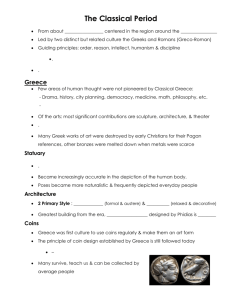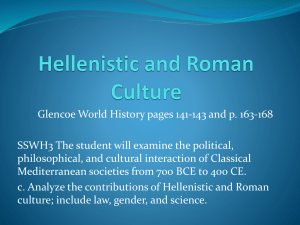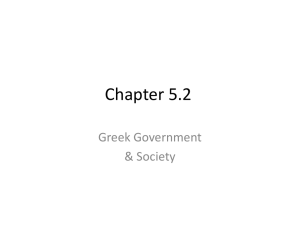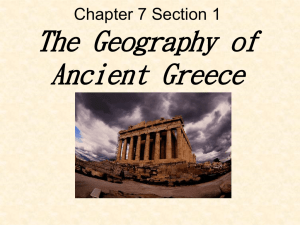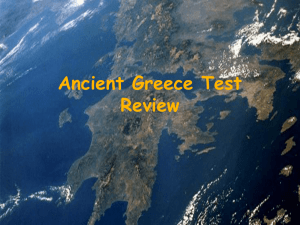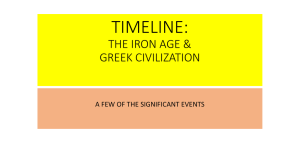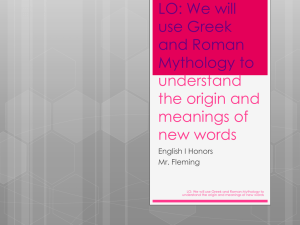Chapter_One_Greek_Culture_and_Roman_Culture
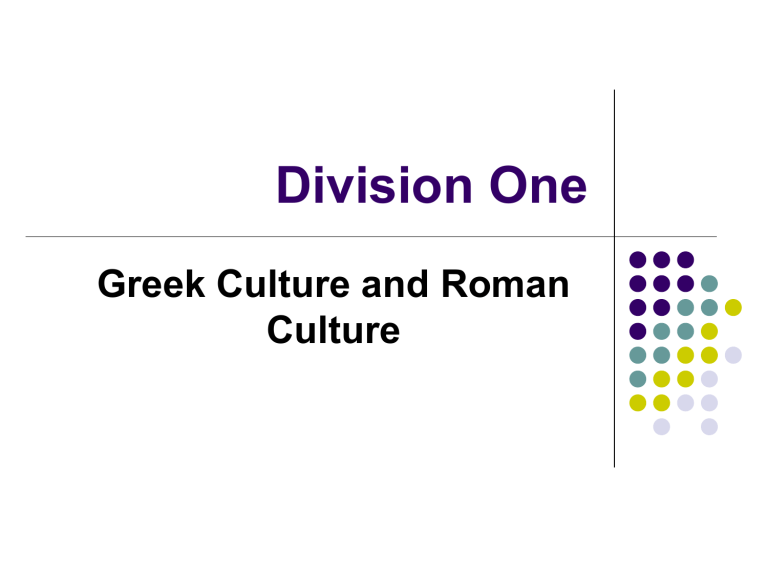
Division One
Greek Culture and Roman
Culture
Warm-up Questions ?
How much do you know about Greece (ancient or modern)?
Do you know when the first Modern Olympic Games was held?
Homer was famous for two epics. Do you know what they are?
There are many famous philosophers in ancient
Greece. Could you name some of them?
You must have ever heard of the following sentence,
―Give me a place to stand, and I will move the world.‖ Do you know who said it?
Lecture Focus
Greek Culture
Roman Culture
Greek Culture
A. The Historical Context
(1). 1200 B.C. the war of Troy
a war was fought between Greece and Troy, ending in the destruction of Troy.
(2). 5th century B.C. Greek culture reached a high point of development.
--- successful repulse of the Persian invasion
--- the establishment of democracy
--- the flourishing of science, philosophy, literature, art and historical writing in Athens
The century closed with civil war between Athens and Sparta
(3). In the second half of the 4th century
B.C., all Greece was brought under the rule of Alexander, king of Macedon
Greek culture was spread
(4). In 146 B.C. the Romans conquered
Greece
B. Social and Political Structure
Politics --- Athens was a democracy
Democracy means ―exercise of power by the whole people.‖
But ―the whole people‖ the Greeks meant only the adult male citizens.
Economy --- the economy of Athens rested on an immense amount of slave labor.
Slaves worked on farms, workshops, and mines.
There was harsh exploitation in Greek society.
Sports --- Greeks loved sports
A big festival on Olympus Mount once every 4 year
---- Olympic Games
Modern Olympic Games revived in 1896 顾拜旦 ( 法 )
C. Homer ( probably lived around 700
B.C.)
---see P3
Two epics: the Iliad
伊利亚特
and the
Odyssey
奥德赛
They are about great men and wars of a remoter age, probably in the period
1200 —1100 B.C.
D. Lyric Poetry
Sappho (about 612 —580 B.C.) 萨福 woman poet
She is noted for her love poems of passionate intensity, some of which are addressed to women.
She was considered the most important lyric poet of ancient Greece. Many Greek and Latin writers know nearly all her poems by heart.
But in the 10th century the Christian church burned her works.
Only fragments remain. Two samples
(1)
I could not hope
To touch the sky
With my two arms
(2)
In gold sandals
Dawn like a thief
Fell upon me
Pindar (about 518 —438 B.C.) 品达
He is best known for his odes celebrating the victories at the athletic games, such as the 14
Olympian odes. Pindar also had imitators, such as the 17th-century English poet John
Dryden.
E. Drama
Origin: perform plays at religious festivals.
Develop: in the 5th century B.C. a powerful drama developed
States: open-air theatres, audience sat on stone benches and looked down at the stage from three sides, actors wore masks.
a. Tragedy
Aeschylus (525 — 456 B.C.) 埃斯库罗斯
Works: Prometheus Bound 被缚的普罗米修斯 ,
Persians
波斯人
, and Agamemnon
阿伽门农
In these plays there are only two actors and a chorus. Yet they manage to stir and move the audience deeply by showing heroes and heroines in complicated human situations, out of which there is no escape but death. The play are written in verse.
Aeschylus is noted for his vivid character portrayal and majestic poetry.
Sophocles (496 --- 406 B.C.) 索福克勒斯
Works: Oedipus the King , Electra 《厄勒克特拉》 , and Antigone 《安提戈涅》 .
Contribution: he added a third actor and decreased the size of the chorus.
Sophocles has had a strong impact on European literature. Some of his plots were taken over and adopted by later writers. The Austrian psychiatrist
Sigmund Freud‘s term ―the Oedipus complex‖ was also derived from Sophocles' play.
Euripides (484 --- 406 B.C.) 欧里庇得斯
Works: Andromache 《安德洛玛刻》 , Medea
《美狄亚》 , and Trojan Women
b. Comedy
Aristophanes (about 450 --- 380 B.C.) 阿里
斯托芬
Works: Frogs, Clouds, Wasps 马蜂 and
Birds
These plays are loose in plot and satirical in tone.
F. History
Historical writing started early in Greece.
Herodotus (484 --- 430 B.C.) 希罗多德
―Father of History‖, he wrote about the wars between Greeks and Persians.
His history, full of anecdotes and digressions and lively dialogue, is wonderfully readable.
He kept alive many traditional stories, which were not always accurate.
His object in writing was ―that the great and wonderful deeds done by Greeks and Persians should not lack renown.‖
Thucydides (about 460 --- 404 B.C.) 修昔底
德
Younger than Herodotus, he is more accurate as an historian.
He traced events to their causes and brought out their effects.
He was never dull, but wrote with imagination and power.
He was called ―the greatest historian that ever lived.‖ by Macaulay (an eminent historian)
G. Philosophy and Science
The ancient Greeks were curious about many things, including what made the universe.
They had the spirit of free enquiry and were quite ready to drop established ideas, to speculate, to use their imagination and to form their own conclusions. They were also not afraid to speak their minds.
Pythagoras (about 580 --- 500 B.C.) 毕达哥拉斯 had the idea that all things were numbers.
Heracleitus (about 540 --- 480 B.C.) 赫拉克勒斯 believed fire to be the primary element of the universe
He also said: You cannot step twice into the same river. The sun is new everyday
Democritus (about 460 --- 370 B.C.) 德谟克利
特 speculated about the atomic structure of matter.
He was one of the earliest exponents of the atomic theory.
Great Philosophers
a.
Socrates ( about 470 --- 399 B.C.) details in textbook P-23
The dialectical method --- method of argument, by questions and answers.
Greek philosopher who initiated a question-and-answer method of teaching as a means of achieving self-knowledge. His theories of virtue and justice have survived through the writings of Plato, his most important pupil. Socrates was tried for corrupting the minds of Athenian youth and subsequently put to death (399).
苏格拉底希腊哲学家,首创了问答工教学方法,作为获得认识自
我的一种方法。他关于道德和正义的理论,通过柏拉图(他最著
名的学生)的著作而得以流传下来。苏格拉底因被指控毒害雅典
年轻人的头脑而受到审判,并因此被处死(公元前 339 年)。
b.
Plato
( about 428 ---348 B.C.) P-
26
Men have knowledge because of the existence of certain general ―ideas‖, like beauty, truth, goodness.
Only these ―ideas‖ are completely real, while the physical world is only relatively real.
For this reason, Plato‘s philosophy is called
Idealism.( 唯心主义 )
Greek philosopher. A follower of Socrates, he founded the Academy (386), where he taught and wrote for much of the rest of his life. Plato presented his ideas in the form of dramatic dialogues, as in The Republic .
柏拉图希腊哲学家,苏格拉底的信徒,他创办了学园
(公元前 386 年),在这里他教书写作度过他余生的大部
分时间柏拉图以戏剧对话的形式表述了他的思想,如在
理想国中。
c. Aristotle (384 --- 322 B.C.) P- 27
Greek philosopher. A pupil of Plato, the tutor of
Alexander the Great, and the author of works on logic, metaphysics, ethics, natural sciences, politics, and poetics, he profoundly influenced Western thought. In his philosophical system theory follows empirical observation and logic, based on the syllogism, is the essential method of rational inquiry.
亚里士多德希腊哲学家。柏拉图的学生,亚历山大大帝的
教师,他的著述论及逻辑学,形而上学,伦理学,自然科
学,政治学和诗学,对西方思想产生了深远影响,在其哲
学体系里,理论服从实地观察和逻辑,以三段论为基础,
基本上是理性研究的理论方法。
d. Contending Schools of Thought
Sophists 诡辩学派 500 B.C.
代表人物: Protagoras
Representative works: On the God 诸神论
His Doctrine: Man is the measure of all things.
Forerunner of Socratic dialectic
Emphasis on ability to argue for any case regardless of its truth
Cynics :犬儒学派 300 B.C.
Under the leadership of Diogenes
Views : simplicity brotherhood rejecting conventions---he had no patience with the rich and the powerful.
Sceptics 置疑学派
Under the leadership of Pyrrhon
Views:
Not all knowledge is attainable.
He doubted the truth of what others accepted as true.
Wise men should not judge, but should aim at balanced imperburbability.
Epicureans 伊壁鸠鲁学派 / 享乐派
Under the leadership of Epicurus —materialist, the world consisted of atoms.
Views:
Pleasure is the highest good of life, achieved through practiced virtue.
Different from hedonism( 享乐主义)- through sensual indulgence.
Stoics 斯多葛派,禁欲主义学派
Under the leadership of Zeno--materialist antithesis of Epicureans
Views: virtue, not pleasure, is the highest good.
Duty
Hardship
e. Science
Euclid 欧几里得 ( 约公元前 3 世纪的古希腊数学
家 ) is even now well-known for his Element
《几何原本》 , a textbook of geometry, perhaps the most successful textbook ever written, because it was in use in English schools until the early years of the 20th century.
Archimedes 阿基米德 (287 —212 B.C.) did important work not only in geometry 几
何学 , but also in arithmetic 算数学 , mechanics, and hydrostatics 流体静力学 .
― Give me a place to stand, and I will move the world .‖
Greek science did not neglect application.
Mathematics, the purest of sciences, was applied in at least five fields: acoustics 声
学 , optics 光学 , geography, statics 静力学 and astronomy 天文学 .
Greek scientists collected a wealth of material and enquired into the proper method of doing scientific work. As a result, they were able to deduce theories and built up systems, which had a tremendous influence on later scientists.
H. Architecture
a. Art
Greek art is a visual proof of Greek civilization.
b. Architecture
Greek architecture can be grouped into 3 styles
(1). the Doric Style ( masculine style ) 多利安式的
---- is sturdy (strong and firm), powerful, severe looking, showing a good sense of proportions and numbers.
(2). the Ionic Style ( feminine style ) 爱奥尼亚
式的
---- is graceful and elegant (slightly ornamental style ) ( While the Doric Style is monotonous and unadorned, the Ionic style often shows a wealth of ornament)
(3). Corinthian Style 科林斯式的
---- is known for its ornamental luxury
The famous temples:
Parthenon (447 -- 432 B.C.) 帕台农神殿 --- the most perfect of all the Greek temples, 240 feet long and 110 feet wide, a rectangular structure with evenly spaced lines of columns around
Acropolis (437 – 432 B.C.)
c. Sculpture
The earliest Greek sculptures were those of Gods. Stiff, lifeless wood carvings.
Towards the 7th century B.C., the size of the statues became bigger and life-size. The figures stand very stiff with arms close to their sides, hands clenched or flat against the legs. Narrow waists but broad shoulders and their hair was done in neat and rhythmical rows.
Towards the 5th century B.C., change from stiff and mechanical to a period in which the beauty of the internal structure of human bodies and mythological figures are well-observed and brought out.
Discus Thrower 掷铁饼者
A good sense of harmony and the balance of opposites
Venus de Milo 米洛的维纳斯
It has been looked upon as a symbol of beauty, grace and health, a personification of vitality and dignity.
Laocoon group about 125 B.C. 拉奥孔人物
组雕
It is known for its successful depiction of the expression of Laocoon‘s face – fear, sympathy and terror.
d. Pottery
The flourishing of the Greek pottery was a result of domestic needs and needs for foreign trade.
There were Black-figure paintings (700 – 600
B.C.) and Red-figure paintings ( --50 B.C.)
The Black-figure paintings are paintings on pottery that have red background and black figure.
The Red-figure paintings are paintings on pottery that have black background and pink figure.
I. Impact
There has been in Europe and elsewhere an enduring excitement about classical Greek culture.
Rediscovery of Greek culture played a vital part in the Renaissance in Italy and other
European countries.
Three qualities stand out:
a. Spirit of Innovation
―They invented mathematics and science and philosophy; they first wrote history as opposed to mere annals; they speculated freely about the nature of the world and the ends of life, without being bound in the fetters of any inherited orthodoxy.‖ (Bertand Russell: History of Western
Philosophy)
b. Supreme Achievement
The Greeks achieved supreme achievements in nearly all fields of human endeavor; philosophy, science, epic poetry, tragedy, comedy, lyric poetry, historical writing, architecture, sculpture, etc.
c. Lasting Effect
Philosophy
Literature: Byron‘s Isles of Greece , Shelley‘s
Hellas and Prometheus Unbound and Keats‘s
Ode on a Grecian Urn .
Roman Culture
146 B.C. Roman conquered Greece
Latin ----western half of the Roman Empire
Greeks---- Eastern
27 B.C. Octavius emperor of Augustus the following 2 centuries Roman Empire reached its greatest extent the Mediterranean, north —Scotland, east —Amenia & Mesopotamia
3rd century the Empire began to decline
4th century the emperor Constantine Capital Rome---Byzantium renamed it Constantinople (modern Istanbul)
395 divided into east(the Byzantine Empire) and west
476 the end of West Roman Empire
1453 the end of East Roman Empire
Romans and Greeks
The common things: .The Roman had a lot in common with the Greek
(In politics). Both peoples had traditions rooted in the idea of the citizen assembly, hostile to monarchy and to servility.
(In religions). Their religions were alike enough for most of their deities to be readily identified---Greek
Zeus with Roman Jupiter, Greek Aphrodite with
Roman Venus, and so on---and their myths to be fused.
(In languages). Their languages worked in similar ways, and were ultimately related, both being members of the Indo-European language family.
The differences:
.There was one big difference
.The Romans built up a vast empire; the
Greeks didn‘t. Except for the brief moment of
Alexander‘s conquests, which soon disintegrated.
Roman Law
In its earliest stage : patricians 贵族 customary legal procedure
In the mid-3rd century B.C. : plebeians 平民 the rules put into writing
Further development: the law was codified
Eventually became the core of modern civil and commercial law in many western countries.
Latin Literature
a. Prose
Two men active on the political scene wrote memorable prose
. Marcus Tullius Cicero (106 —43B.C.) 西塞罗
He played an important role in the Roman senate
Noted for his oratory 演说术 and fine writing style
His legal and political speeches are models of Latin diction.
Ciceronian —eloquent, oratorical manner of writing
. Julius Caesar (102/100?
–44B.C.) 凯撒
a general, dictator, assassinated.
He recorded what he did and saw in the various military campaigns
These writings, collected in his
Commentaries , are models of succinct Latin.
He use language with economy and ferocity
―I came, I saw, I conquered.‖
b. Poetry
. Lucretius (93 —50 B.C.) 卢克莱修
He wrote the philosophical poem On the
Nature of Things 物性论
. Virgil (70 —19 B.C.) 维吉尔
The greatest of Latin poets, wrote the great epic, the Aeneid 埃涅阿斯纪
Architecture, Painting and Sculpture
i. Architecture
The Romans were great engineers. They covered their world from one end to the other with roads, bridges, aqueducts, theatres and arenas
. The Pantheon (万神庙) ..\ 欧洲文化图片资料
\Pantheon, Rome - Wikipedia, the free encyclopedia.htm
The greatest and the best preserved Roman temple, which was built in 27 B.C. and reconstructed in the
2nd century A.D
. Pont du Gard (加德桥输水道) ..\ 欧洲文化图片资
料 \Pont du Gard - Wikipedia, the free encyclopedia.htm
It is an exceptionally well-preserved aqueduct that spans a wide valley in south France the Colosseum ( 古罗马圆形大斗兽场 ) ..\ 欧洲文化图
片资料 \Colosseum - Wikipedia, the free encyclopedia.htm
It is an enormous amphitheatre built in the centre of
Rome in imperial times. A masterpiece of engineering, it held more than 5000 spectators. Its interior is twothird of a mile round.
The Colosseum was used for games, contests and shows.
ii. Painting
Roman painting was strongly influenced by the art of Greece. Unfortunately much of the painting no longer exists. There are, however, some wall-paintings from Pompeii and other towns near Naples. These wall-paintings include still life, landscape paintings and figure paintings.
iii. Sculpture
.
she —wolf ..\ 欧洲文化图片资料 \Capitoline Wolf -
Wikipedia, the free encyclopedia.htm
A statue which illustrates the legend of the creation of Rome. Today at the site of the city‘s founding, there stands a statue of the she-wolf
Constantine the Great (4th Century B.C.)
Spoils from the Temple in Jerusalem (81 A.D)
